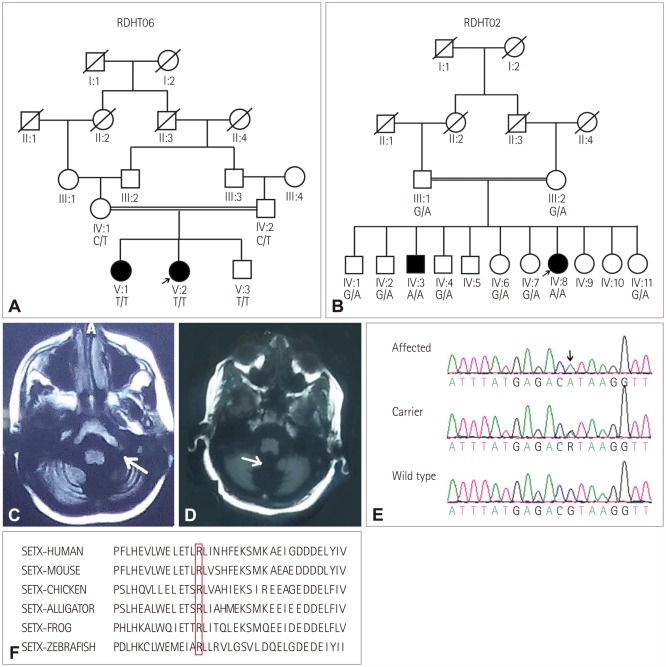1. Hammer MB, Ding J, Mochel F, Eleuch-Fayache G, Charles P, Coutelier M, et al. SLC25A46 mutations associated with autosomal recessive cerebellar ataxia in North African families. Neurodegener Dis. 2017; 17:208–212. PMID:
28558379.

2. Breedveld GJ, van Wetten B, te Raa GD, Brusse E, van Swieten JC, Oostra BA, et al. A new locus for a childhood onset, slowly progressive autosomal recessive spinocerebellar ataxia maps to chromosome 11p15. J Med Genet. 2004; 41:858–866. PMID:
15520412.

3. Brunberg JA. Expert Panel on Neurologic Imaging. Ataxia. AJNR Am J Neuroradiol. 2008; 29:1420–1422. PMID:
18701585.
4. Mansfield SA, Pilarski R, Agnese DM. ATM mutations for surgeons. Fam Cancer. 2017; 16:407–410. PMID:
27988859.

5. Wright J, Teraoka S, Onengut S, Tolun A, Gatti RA, Ochs HD, et al. A high frequency of distinct ATM gene mutations in ataxia-telangiectasia. Am J Hum Genet. 1996; 59:839–846. PMID:
8808599.
6. Davis MY, Keene CD, Swanson PD, Sheehy C, Bird TD. Novel mutations in ataxia telangiectasia and AOA2 associated with prolonged survival. J Neurol Sci. 2013; 335:134–138. PMID:
24090759.

7. Sandoval N, Platzer M, Rosenthal A, Dörk T, Bendix R, Skawran B, et al. Characterization of ATM gene mutations in 66 ataxia telangiectasia families. Hum Mol Genet. 1999; 8:69–79. PMID:
9887333.

8. Sasaki T, Tian H, Kukita Y, Inazuka M, Tahira T, Imai T, et al. ATM mutations in patients with ataxia telangiectasia screened by a hierarchical strategy. Hum Mutat. 1998; 12:186–195. PMID:
9711876.

9. Roohi J, Crowe J, Loredan D, Anyane-Yeboa K, Mansukhani MM, Omesi L, et al. New diagnosis of atypical ataxia-telangiectasia in a 17-year-old boy with T-cell acute lymphoblastic leukemia and a novel ATM mutation. J Hum Genet. 2017; 62:581–584. PMID:
28123174.

10. Bernstein JL. WECARE Study Collaborative Group. Concannon P. ATM, radiation, and the risk of second primary breast cancer. Int J Radiat Biol. 2017; 93:1121–1127. PMID:
28627265.

11. Lavin MF, Yeo AJ, Becherel OJ. Senataxin protects the genome: implications for neurodegeneration and other abnormalities. Rare Dis. 2013; 1:e25230. PMID:
25003001.
12. Becherel OJ, Yeo AJ, Stellati A, Heng EY, Luff J, Suraweera AM, et al. Senataxin plays an essential role with DNA damage response proteins in meiotic recombination and gene silencing. PLoS Genet. 2013; 9:e1003435. PMID:
23593030.

13. Yeo AJ, Becherel OJ, Luff JE, Graham ME, Richard D, Lavin MF. Senataxin controls meiotic silencing through ATR activation and chromatin remodeling. Cell Discov. 2015; 1:15025. PMID:
27462424.

14. Choudhury SD, Vs A, Mushtaq Z, Kumar V. Altered translational repression of an RNA-binding protein, Elav by AOA2-causative senataxin mutation. Synapse. 2017; 3. 09. [Epub]. DOI:
10.1002/syn.21969.

15. Mariani LL, Rivaud-Péchoux S, Charles P, Ewenczyk C, Meneret A, Monga BB, et al. Comparing ataxias with oculomotor apraxia: a multimodal study of AOA1, AOA2 and AT focusing on video-oculography and alpha-fetoprotein. Sci Rep. 2017; 7:15284. PMID:
29127364.

16. Bassuk AG, Chen YZ, Batish SD, Nagan N, Opal P, Chance PF, et al. In cis autosomal dominant mutation of senataxin associated with tremor/ataxia syndrome. Neurogenetics. 2007; 8:45–49. PMID:
17096168.

17. Rudnik-Schöneborn S, Eggermann T, Kress W, Lemmink HH, Cobben JM, Zerres K. Clinical utility gene card for: proximal spinal muscular atrophy (SMA)-update 2015. Eur J Hum Genet. 2015; 5. 20. [Epub]. DOI:
10.1038/ejhg.2015.90.
18. Rudnik-Schöneborn S, Arning L, Epplen JT, Zerres K. SETX gene mutation in a family diagnosed autosomal dominant proximal spinal muscular atrophy. Neuromuscul Disord. 2012; 22:258–262. PMID:
22088787.

19. Ciesla N, Dinglas V, Fan E, Kho M, Kuramoto J, Needham D. Manual muscle testing: a method of measuring extremity muscle strength applied to critically ill patients. J Vis Exp. 2011; 50:pii: 2632.

20. Nishida K, Kuwano Y, Nishikawa T, Masuda K, Rokutan K. RNA binding proteins and genome integrity. Int J Mol Sci. 2017; 18:E1341. PMID:
28644387.

21. Berger ND, Stanley FKT, Moore S, Goodarzi AA. ATM-dependent pathways of chromatin remodelling and oxidative DNA damage responses. Philos Trans R Soc Lond B Biol Sci. 2017; 372:20160283. PMID:
28847820.

22. Telatar M, Teraoka S, Wang Z, Chun HH, Liang T, Castellvi-Bel S, et al. Ataxia-telangiectasia: identification and detection of founder-effect mutations in the ATM gene in ethnic populations. Am J Hum Genet. 1998; 62:86–97. PMID:
9443866.

23. Groh M, Albulescu LO, Cristini A, Gromak N. Senataxin: genome guardian at the interface of transcription and neurodegeneration. J Mol Biol. 2017; 429:3181–3195. PMID:
27771483.

24. Richard P, Feng S, Manley JL. A SUMO-dependent interaction between senataxin and the exosome, disrupted in the neurodegenerative disease AOA2, targets the exosome to sites of transcription-induced DNA damage. Genes Dev. 2013; 27:2227–2232. PMID:
24105744.

25. Duquette A, Roddier K, McNabb-Baltar J, Gosselin I, St-Denis A, Dicaire MJ, et al. Mutations in senataxin responsible for Quebec cluster of ataxia with neuropathy. Ann Neurol. 2005; 57:408–414. PMID:
15732101.

26. Kenna KP, McLaughlin RL, Byrne S, Elamin M, Heverin M, Kenny EM, et al. Delineating the genetic heterogeneity of ALS using targeted high-throughput sequencing. J Med Genet. 2013; 50:776–783. PMID:
23881933.

27. Chen YZ, Bennett CL, Huynh HM, Blair IP, Puls I, Irobi J, et al. DNA/RNA helicase gene mutations in a form of juvenile amyotrophic lateral sclerosis (ALS4). Am J Hum Genet. 2004; 74:1128–1135. PMID:
15106121.

28. Fogel BL, Cho E, Wahnich A, Gao F, Becherel OJ, Wang X, et al. Mutation of senataxin alters disease-specific transcriptional networks in patients with ataxia with oculomotor apraxia type 2. Hum Mol Genet. 2014; 23:4758–4769. PMID:
24760770.







 PDF
PDF ePub
ePub Citation
Citation Print
Print


 XML Download
XML Download